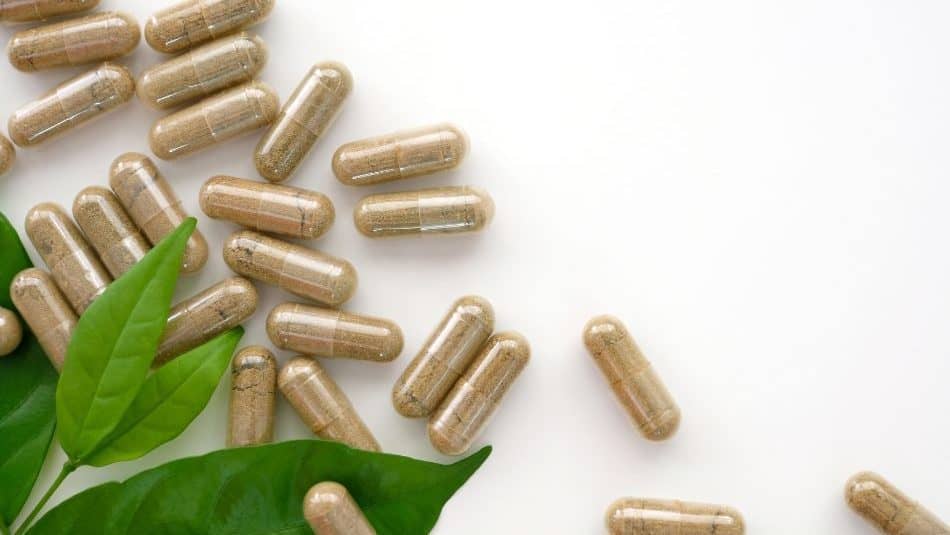
Saw Palmetto appears to be one of the most powerful anti-androgenic herbs that may be particularly beneficial for women with PCOS (Polycystic Ovary Syndrome). But how exactly can this plant affect your hormones? And are there any side effects?
That’s what you’ll find out in this evidence-based article where I discuss all the benefits and potential risks of Saw Palmetto for PCOS. I’ll also give you some practical tips on how to best use this herbal remedy to gain the most benefits.
If you’d like to learn more about the role of other lifestyle factors in the management of PCOS, make sure to check out my detailed guide: ‘How To Treat PCOS Naturally (Science-Based Guidelines)’
What is Saw Palmetto?
Saw Palmetto, also known as Serenoa Rapens, is a small palm tree native to the south-eastern regions of the US. The extract from this plant and its fruits (dark berries) has been used for centuries in herbal medicine for its hormone-balancing properties.
Despite the limited research investigating the effects of Saw Palmetto on PCOS, there are several ways in which this herb may help manage this endocrine disorder and reduce its symptoms.
Benefits of Saw Palmetto for PCOS:
- Decreased androgens
- Reduced hair loss
- Improved hirsutism
- Reduced Acne
- Anti-inflammatory effects
✓ Decreased androgens
One of the reasons why Saw Palmetto appears to have anti-androgenic effects is due to its ability to reduce the production of DHT. DHT (dihydrotestosterone) is a type of powerful androgenic hormone (typically high in males) that is converted from testosterone by the enzyme 5-AR (2-alpha-reductase).
Unfortunately, high levels of DHT are a typical feature of PCOS due to the increased activity of 5-AR in women with this condition. As a result, excess levels of DHT in women with PCOS lead to some of the most common ‘male-like’ symptoms (such as hirsutism, hair loss, acne, loss of periods).
The good news is that Saw Palmetto has been shown to inhibit the activity of 5-AR and significantly reduce the production of DHT (the same way that anti-androgenic drugs work). Those effects are believed to be due to the high content of certain liposterols found in the plant. Saw Palmetto is therefore considered to be a natural anti-androgenic compound and DHT blocker.
✓ Reduced hair loss
Androgenic alopecia (male pattern baldness) is one of the visible consequences of increased levels of DHT in the body since DHT is largely involved in the hair growth cycle. It’s also the reason why so many women with PCOS experience excessive hair loss, especially around the center and front of the scalp.
I’ve written a detailed article about how to address this issue and how to regrow your hair naturally that you can access here: ‘PCOS Hair Loss Explained & How To Reverse It‘.
One of the strategies is to include natural DHT blockers in your diet and Saw Palmetto has been shown to be effective in combating hair loss in multiple studies (both animal and human). For this reason, Saw Palmetto is oftentimes recommended to individuals (both men and women) suffering from androgenic alopecia and hormone-related hair loss.
✓ Improved hirsutism
Hirsutism (excessive body hair growth) is another common feature of PCOS that many women with this condition experience. As I’ve already mentioned, DHT is the main hormone involved in hair growth regulation (including body hair).
This is why increased levels of DHT can stimulate the growth of terminal hairs (thick and dark) in androgen-sensitive body parts (typical for men) in women. You can find more details about this topic in my other article ‘PCOS Hirsutism Explained & How To Reverse It‘.
Even though there’s currently a lack of evidence about the effects of Saw Palmetto on excessive hair growth in women with PCOS, it is one of the most widely recommended natural supplements to combat hirsutism due to its anti-androgenic properties.
✓ Reduced acne
Hormonal acne (another common symptom of PCOS) is also closely related to the levels of DHT in your bloodstream. That’s because DHT stimulates the production of sebum (natural oil) that flows to your skin surface. Too much DHT can therefore trigger excessive release of sebum and contribute to oily skin, blockage, bacteria overgrowth and acne development.
Read more: ‘PCOS Acne Explained & How To Treat It Naturally‘
Since Saw Palmetto helps reduce the production of DHT in the body, it is argued that it may be an effective strategy to treat hormone-related acne. Unfortunately, there are currently no scientific data to support the beneficial effects of Saw Palmetto on acne, however, many women with PCOS (me included) reported improvements in their skin after taking a Saw Palmetto supplement.
✓ Anti-inflammatory effects
It is suggested that Saw Palmetto may also be effective in reducing inflammation as it’s been demonstrated in several studies (although they were all animal studies). Those anti-inflammatory effects are mainly credited to the high levels of antioxidants found in the plant.
Because chronic inflammation and increased levels of oxidative stress are closely related to the development and progression of PCOS, women with this condition are strongly encouraged to lower those markers through dietary and lifestyle changes. And Saw Palmetto berries (or an extract) could be a great way to do that
Disadvantages of Saw Palmetto for PCOS:
- Hormone imbalance
- Side effects
✕ Hormone imbalance
One of the things to keep in mind is that besides androgens, Saw Palmetto may also affect other hormones in your body. In women, Saw Palmetto appears to have anti-estrogenic and anti-prolactin effects, although more research is required to confirm that.
While this can be beneficial for some women with PCOS (those with estrogen dominance and excessive prolactin levels), it could contribute to further hormone imbalances in others. For this reason, it’s important to know your own hormone levels and consult with a health professional, especially when taking hormonal contraceptives.
✕ Side effects
Saw Palmetto is generally considered safe for most individuals as there have been reported no severe side effects. However, it should be noted that some people might experience mild headaches, dizziness, nausea and constipation after the consumption of Saw Palmetto supplements.
Nonetheless, due to the hormone-altering properties of this plant, Saw Palmetto is not recommended for women who are pregnant or breastfeeding. Children are also encouraged to avoid taking Saw Palmetto supplements.
Best Saw Palmetto for PCOS:
- Saw Palmetto supplements
- Saw Palmetto tea
- Saw Palmetto berries
- Saw Palmetto powder
While most of the research on Saw Palmetto has been conducted using the plant’s extract in a form of supplements (capsules, tinctures), you can also find it in other forms (whole berries, tea, powder). Based on your personal preferences, you can choose the type that best fits within your lifestyle.
However, since dietary supplements are generally very poorly regulated (not by governmental bodies such as FDA) you want to pay close attention to their quality to ensure their safety and effectiveness. Try to opt for supplements that have been third-party tested (to ensure their content quality) and from reliable brands (I share some of my favorites later in this post).
You’re also likely to find Saw Palmetto supplements in combination with other natural DHT blockers (such as pumpkin seed extract, stinging nettle) that are usually labeled as hair loss supplements or prostate support (DHT plays a major role in prostate in men). However, in such supplements, the concentration of Saw Palmetto is likely to be much lower.
Is Saw Palmetto good for PCOS?
In general, Saw Palmetto can be considered good for PCOS due to its anti-androgenic and anti-inflammatory properties. Women with PCOS suffering from excessive hair loss, hirsutism and acne may benefit the most from taking Saw Palmetto supplements. However, the effects may differ between individuals.
What does saw palmetto taste like?
The taste of Saw Palmetto berries can be described as slightly peppery with a sweet undertone and an oily consistency. The flavor is relatively strong and oftentimes compared to blue cheese. While Saw Palmetto berries can be eaten raw, they are typically cooked or dried prior to consumption.
Can I take Saw Palmetto with PCOS?
Taking Saw Palmetto supplements is generally considered safe for most women with PCOS who are not pregnant, breastfeeding or on hormonal contraceptives. However, the effectiveness of Saw Palmetto supplements may greatly vary between individuals based on their unique hormonal profiles.
Best Saw Palmetto supplements for PCOS:
- Saw Palmetto Capsules by Nature’s Way (available on Amazon)
- Organic Saw Palmetto Berries by Starwest Botanicals (available on Amazon)
- Saw Palmetto Extract by Nature’s Answer (available on Amazon)
These are some of my favorite products I’ve used in the past and that were great in terms of their quality and effectiveness. I personally prefer Saw Palmetto supplements as I’m not the biggest fan of its taste (and smell) and it’s also the most convenient way to take it. However, some people find the unique taste of Saw Palmetto pleasant.
How to use Saw Palmetto for PCOS:

Saw Palmetto can be easily incorporated into a diet in many different ways and forms. Depending on the type and brand of Saw Palmetto products, the effects on PCOS may vary. However, there are some general recommendations based on the research findings that may be followed to maximize the positive effects.
How much Saw Palmetto should I take for PCOS?
As a general rule, women with PCOS should consume between 160-320 mg of Saw Palmetto per day to achieve the most health benefits. However, the optimal dosage of Saw Palmetto for PCOS may differ between individuals depending on their personal circumstances and the type of supplement used.
When is the best time to take Saw Palmetto for PCOS?
The best time to take Saw Palmetto supplements for PCOS appears to be with meals as it may help prevent digestive issues and adverse effects. However, Saw Palmetto supplements can be consumed at any time of the day depending on personal preferences and lifestyle arrangements.
How long does it take for Saw Palmetto to work for PCOS?
In general, most women with PCOS start noticing significant improvements in their symptoms after a minimum of 6 weeks of regular Saw Palmetto supplementation. However, the length of this period may be affected by the severity of hormone imbalances and other important factors.
Pro tips:
- Track your progress – get tested and keep a track of your progress, with enough data you’re more likely to see what strategies and supplements work for you best and it also helps you stay motivated, you can find some useful tools here ‘TOP 5 Smart Devices To Monitor & Manage PCOS‘
- Create a routine – consistency is key for taking supplements so creating a solid daily routine can make it easy for you to stick to your plan and get better results, try to take it at the same time of the day (eg. with lunch, breakfast or dinner) every day
- Use a supplement container – if you take multiple supplements a day I highly suggest using one of those practical containers where you can pre-arrange your tablets for each day, it makes taking supplements way more effortless
- Eat a healthy diet – don’t forget that supplements are not a replacement for a healthy diet and making the right dietary choices should remain your priority, here’s an easy-to-follow plan to get the most benefits ‘The Best PCOS Diet (Ultimate Guide)‘
- Drink a lot of water – make sure you drink a lot of fluids with your supplements so it’s easier for your body to digest and absorb those nutrients
- Be patient – don’t expect any overnight results, keep in mind that your body is a complex system that doesn’t like rapid changes – it usually takes several weeks before you start seeing results
Resources:
- Agbabiaka, T. B., Pittler, M. H., Wider, B., & Ernst, E. (2009). Serenoa repens (saw palmetto): a systematic review of adverse events. Drug safety, 32(8), 637–647. https://doi.org/10.2165/00002018-200932080-00003
- Bernichtein, S., Pigat, N., Camparo, P., Latil, A., Viltard, M., Friedlander, G., & Goffin, V. (2015). Anti-inflammatory properties of Lipidosterolic extract of Serenoa repens (Permixon®) in a mouse model of prostate hyperplasia. The Prostate, 75(7), 706–722. https://doi.org/10.1002/pros.22953
- Colado-Velázquez, J., III, Mailloux-Salinas, P., Medina-Contreras, J., Cruz-Robles, D., & Bravo, G. (2015). Effect of Serenoa Repens on Oxidative Stress, Inflammatory and Growth Factors in Obese Wistar Rats with Benign Prostatic Hyperplasia. Phytotherapy research : PTR, 29(10), 1525–1531. https://doi.org/10.1002/ptr.5406
- Dhariwala, M. Y., & Ravikumar, P. (2019). An overview of herbal alternatives in androgenetic alopecia. Journal of cosmetic dermatology, 18(4), 966–975. https://doi.org/10.1111/jocd.12930
- Fagelman, E., & Lowe, F. C. (2001). Saw Palmetto Berry as a Treatment for BPH. Reviews in urology, 3(3), 134–138. Available at: https://pubmed.ncbi.nlm.nih.gov/16985705/
- Grant, P., & Ramasamy, S. (2012). An update on plant derived anti-androgens. International journal of endocrinology and metabolism, 10(2), 497–502. https://doi.org/10.5812/ijem.3644
- Münzker, J., Hofer, D., Trummer, C., Ulbing, M., Harger, A., Pieber, T., Owen, L., Keevil, B., Brabant, G., Lerchbaum, E., & Obermayer-Pietsch, B. (2015). Testosterone to dihydrotestosterone ratio as a new biomarker for an adverse metabolic phenotype in the polycystic ovary syndrome. The Journal of clinical endocrinology and metabolism, 100(2), 653–660. https://doi.org/10.1210/jc.2014-2523
- Prager, N., Bickett, K., French, N., & Marcovici, G. (2002). A randomized, double-blind, placebo-controlled trial to determine the effectiveness of botanically derived inhibitors of 5-alpha-reductase in the treatment of androgenetic alopecia. Journal of alternative and complementary medicine (New York, N.Y.), 8(2), 143–152. https://doi.org/10.1089/acm.2002.8.143
- Sultan, C., Terraza, A., Devillier, C., Carilla, E., Briley, M., Loire, C., & Descomps, B. (1984). Inhibition of androgen metabolism and binding by a liposterolic extract of “Serenoa repens B” in human foreskin fibroblasts. Journal of steroid biochemistry, 20(1), 515–519. https://doi.org/10.1016/0022-4731(84)90264-4
- Vassiliadi, D. A., Barber, T. M., Hughes, B. A., McCarthy, M. I., Wass, J. A., Franks, S., Nightingale, P., Tomlinson, J. W., Arlt, W., & Stewart, P. M. (2009). Increased 5 alpha-reductase activity and adrenocortical drive in women with polycystic ovary syndrome. The Journal of clinical endocrinology and metabolism, 94(9), 3558–3566. https://doi.org/10.1210/jc.2009-0837
- Wu, C., Wei, K., & Jiang, Z. (2017). 5α-reductase activity in women with polycystic ovary syndrome: a systematic review and meta-analysis. Reproductive biology and endocrinology : RB&E, 15(1), 21. https://doi.org/10.1186/s12958-017-0242-9
- Zeng, X., Xie, Y. J., Liu, Y. T., Long, S. L., & Mo, Z. C. (2020). Polycystic ovarian syndrome: Correlation between hyperandrogenism, insulin resistance and obesity. Clinica chimica acta; international journal of clinical chemistry, 502, 214–221. https://doi.org/10.1016/j.cca.2019.11.003
- Zhu, H. L., Gao, Y. H., Yang, J. Q., Li, J. B., & Gao, J. (2018). Serenoa repens extracts promote hair regeneration and repair of hair loss mouse models by activating TGF-β and mitochondrial signaling pathway. European review for medical and pharmacological sciences, 22(12), 4000–4008. https://doi.org/10.26355/eurrev_201806_15285
